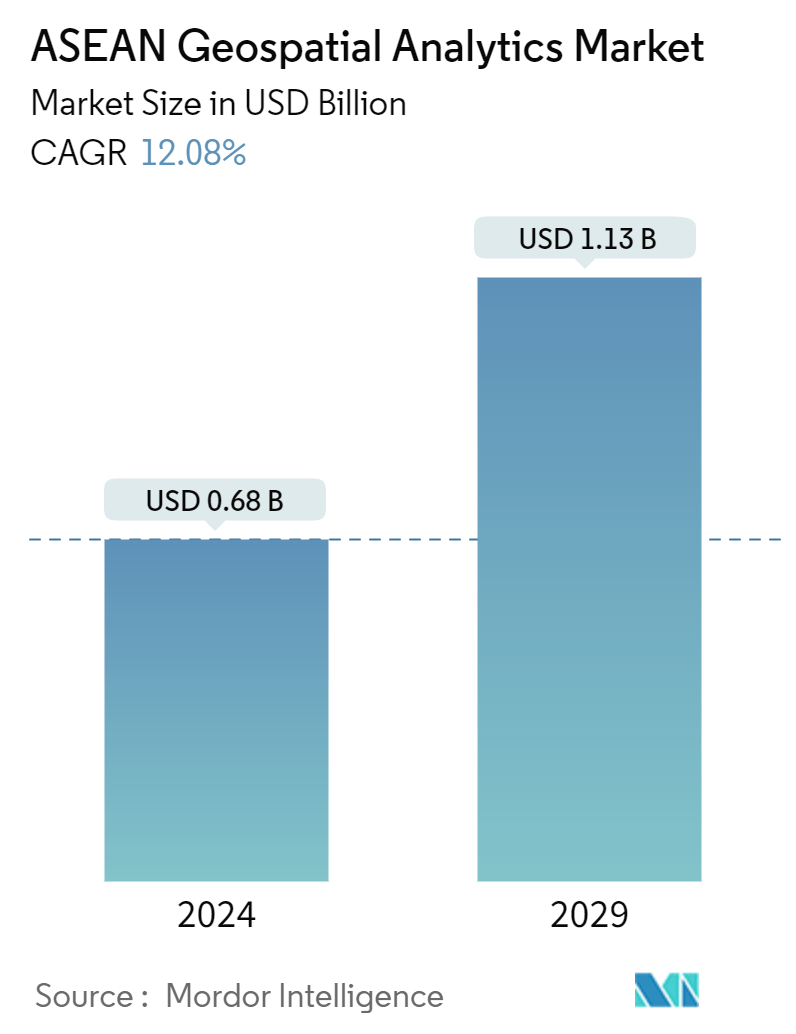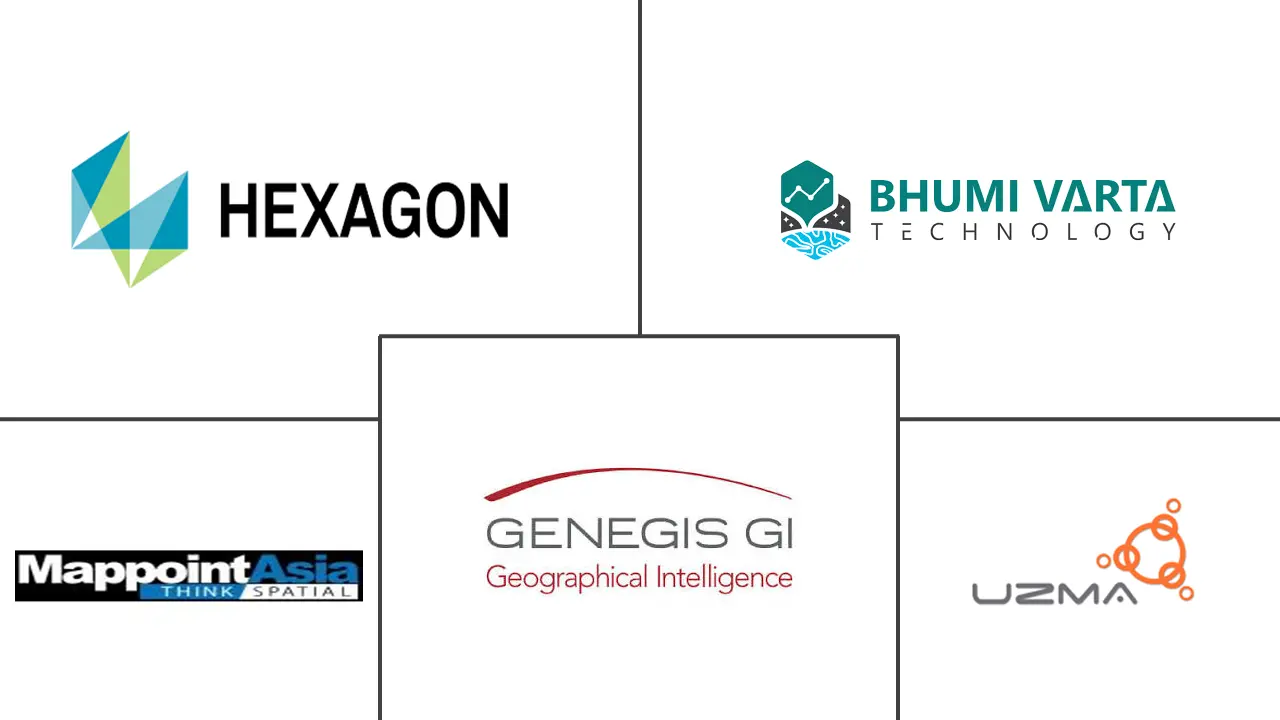Market Size of ASEAN Geospatial Analytics Industry

| Study Period | 2019 - 2029 |
| Base Year For Estimation | 2023 |
| Market Size (2024) | USD 0.68 Billion |
| Market Size (2029) | USD 1.13 Billion |
| CAGR (2024 - 2029) | 12.08 % |
| Market Concentration | Medium |
Major Players
*Disclaimer: Major Players sorted in no particular order |
ASEAN Geospatial Analytics Market Analysis
The ASEAN Geospatial Analytics Market size is estimated at USD 0.68 billion in 2024, and is expected to reach USD 1.13 billion by 2029, growing at a CAGR of 12.08% during the forecast period (2024-2029).
The ASEAN Geospatial Analytics market is majorly driven by the growth in innovative solutions by major market vendors coupled with increasing 5G rollout and integration of advanced technologies such as AI and ML in geospatial analytics solutions.
- The ASEAN geospatial analytics market is witnessing substantial growth over the past few years owing to the evolving role of national geospatial organizations in driving geospatial market growth coupled with the increasing government's efforts to boost the geospatial ecosystem and increasing demand from various end-user industries such as agriculture, environmental monitoring and urban development in South East Asian countries.
- Further, the continuous innovations and integration of advanced technologies such as artificial intelligence and machine learning in geospatial analytics by the leading regional as well as global companies in the region are one of the major factors driving the demand for geospatial solutions in end-user industries across the region. For instance, Indonesia-based Bhumi Varta Technology offers Spatial analysis and analytics with Artificial Intelligence (AI) and machine learning (ML) to lead enterprises to actionable insights.
- Furthermore, the growth in the rollout of 5G services across ASEAN countries is expected to boost the development of the market as 5G technology will accelerate the GIS adoption, enabling the efficient creation of spatial data, thereby furthering geospatial analytics deployment across industries in the ASEAN region. For instance, according to the Ericsson Mobility Report, 5G is expected to become the leading technology in subscriptions in Southeast Asia by 2028, with a penetration rate of 48%.
- Additionally, the use of geospatial analytics is rapidly increasing in smart city projects across ASEAN countries. To better serve the public, smart cities leverage geospatial analytics and all the insights that come with it to make data-driven decisions.
- Market vendors such as Esri Singapore offer geospatial platforms and partner with governments to develop smarter cities and provide better services to the community. Such factors are further expected to elevate the market growth in the coming years.
ASEAN Geospatial Analytics Industry Segmentation
Geospatial analytics is the process of acquiring, manipulating, and displaying imagery and data from the geographic information system (GIS), such as satellite photos and GPS data. The specific identifiers of a street address and a zip code are used in geospatial data analytics. They are used to create geographic models and data visualizations for more accurate trend modelling and forecasting.
The ASEAN geospatial analytics market is segmented by type (surface analysis, network analysis, geovisualization), end user vertical (agriculture, utility and communication, defence and intelligence, government, mining and natural resources, automotive and transportation, healthcare, real estate and construction), and country (Thailand, Indonesia, Malaysia, Singapore). The market sizes and forecasts are provided in terms of USD value for all the above segments.
| By Type | |
| Surface Analysis | |
| Network Analysis | |
| Geo Visualization |
| By End-user Vertical | |
| Agriculture | |
| Utility and Communication | |
| Defense and Intelligence | |
| Government | |
| Mining and Natural Resources | |
| Automotive and Transportation | |
| Healthcare | |
| Real Estate and Construction | |
| Other End-user Verticals |
| By Country | |
| Thailand | |
| Malaysia | |
| Indonesia | |
| Singapore |
ASEAN Geospatial Analytics Market Size Summary
The ASEAN geospatial analytics market is experiencing significant expansion, driven by the integration of advanced technologies such as artificial intelligence and machine learning into geospatial solutions. This growth is further propelled by the rollout of 5G technology, which enhances the adoption of Geographic Information Systems (GIS) and facilitates the efficient creation of spatial data. The market is also benefiting from the increasing demand for geospatial analytics across various sectors, including agriculture, environmental monitoring, and urban development. National geospatial organizations and government initiatives are playing a crucial role in fostering the geospatial ecosystem, particularly in smart city projects where data-driven decision-making is essential. Companies like Esri Singapore and Bhumi Varta Technology are at the forefront, offering innovative solutions that cater to the evolving needs of these industries.
In the agricultural sector, the adoption of geospatial analytics is expected to rise significantly, supported by government policies promoting smart and precision farming practices. This trend is particularly evident in countries like Thailand and Malaysia, where the application of geospatial solutions is enhancing crop management and increasing agricultural productivity. Singapore is also witnessing substantial growth in geospatial analytics adoption across various industries, including healthcare, defense, and real estate. The Singapore Land Authority's collaborations and initiatives are driving the market's expansion, with partnerships aimed at promoting geospatial technology and innovation. The market remains moderately competitive, with key players like GIS Co., Ltd., MappointAsia, and Geospatial AI Sdn Bhd actively engaging in collaborations and product innovations to strengthen their market positions.
ASEAN Geospatial Analytics Market Size - Table of Contents
-
1. MARKET INSIGHTS
-
1.1 Market Overview
-
1.2 Industry Attractiveness - Porter's Five Forces Analysis
-
1.2.1 Bargaining Power of Buyers
-
1.2.2 Bargaining Power of Suppliers
-
1.2.3 Threat of New Entrants
-
1.2.4 Threat of Substitutes
-
1.2.5 Intensity of Competitive Rivalry
-
-
1.3 Industry Value Chain Analysis
-
1.4 Assessment of the Impact of COVID-19 on the Market
-
-
2. MARKET SEGMENTATION
-
2.1 By Type
-
2.1.1 Surface Analysis
-
2.1.2 Network Analysis
-
2.1.3 Geo Visualization
-
-
2.2 By End-user Vertical
-
2.2.1 Agriculture
-
2.2.2 Utility and Communication
-
2.2.3 Defense and Intelligence
-
2.2.4 Government
-
2.2.5 Mining and Natural Resources
-
2.2.6 Automotive and Transportation
-
2.2.7 Healthcare
-
2.2.8 Real Estate and Construction
-
2.2.9 Other End-user Verticals
-
-
2.3 By Country
-
2.3.1 Thailand
-
2.3.2 Malaysia
-
2.3.3 Indonesia
-
2.3.4 Singapore
-
-
ASEAN Geospatial Analytics Market Size FAQs
How big is the ASEAN Geospatial Analytics Market?
The ASEAN Geospatial Analytics Market size is expected to reach USD 0.68 billion in 2024 and grow at a CAGR of 12.08% to reach USD 1.13 billion by 2029.
What is the current ASEAN Geospatial Analytics Market size?
In 2024, the ASEAN Geospatial Analytics Market size is expected to reach USD 0.68 billion.

